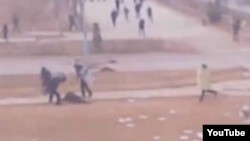RFE/RL reported last week on the video showing police firing on fleeing protesters in the western Kazakh town of Zhanaozen.
Originally uploaded to YouTube on December 20 by a user called saule540, the video challenges the police explanation of the unrest, which left 15 people dead. The authorities had said that they fired into the air and at the ground, and only in self-defense.
Now the police are looking for the person (or people) who shot the video, purportedly from an apartment window on Zhanaozen's main square. RFE/RL's Kazakh Service reports that the regional police chief in the Mangistau district, Amanzhol Kabylov, said that they had located the address but that the residents had not been found and the apartment was empty.
It's another reminder that while the democratization of the ability to bear witness brings substantial rewards (i.e. letting the world know what is going on via the proliferation of smart phones), it comes with substantial risks.
Originally uploaded to YouTube on December 20 by a user called saule540, the video challenges the police explanation of the unrest, which left 15 people dead. The authorities had said that they fired into the air and at the ground, and only in self-defense.
Now the police are looking for the person (or people) who shot the video, purportedly from an apartment window on Zhanaozen's main square. RFE/RL's Kazakh Service reports that the regional police chief in the Mangistau district, Amanzhol Kabylov, said that they had located the address but that the residents had not been found and the apartment was empty.
It's another reminder that while the democratization of the ability to bear witness brings substantial rewards (i.e. letting the world know what is going on via the proliferation of smart phones), it comes with substantial risks.
This theme was covered in a report, "Cameras Everywhere," by the human rights organization WITNESS, which discussed ways "to protect and empower those who attempt to expose injustices through video."
As the report noted:
As the report noted:
[T]he ease of copying, tagging, and circulating images over a variety of platforms adds a layer of risk beyond an individual user's control. All content and communications, including visual media, leave personal digital traces that third parties can harvest, link, and exploit. The authors argue that their safety will need to be considered "at each stage of video production and distribution.
Beyond tracking people down, there are many ways repressive governments -- or nonstate actors -- can attempt to silence witness testimony. For example, flagging videos for terms of service (TOS) violations on sites like YouTube can result in them getting taken down. (The Kazakh police, according to this report, also claim they are in possession of a video that exonerates them, although it's not yet seen the light of day.)
But looking at reporting by our Kazakh Service, good old-fashioned offline intimidation seems to be the tactic of choice (the video is still up on YouTube).
One reader, who asked that his name be withheld for security reasons, said that he heard that they were searching homes and looking on people's mobile phones, presumably for incriminating videos. RFE/RL can't confirm these allegations, but they are consistent with reports of harassment given to media organizations reporting the unrest and the general climate of fear in Zhanaozen, still under curfew until January 5.
Kazakhstan is a vast country -- and thus the western region is relatively easy to isolate in order to stop news getting out and to stop the protests from spreading. The Internet -- in particular social networks and video-sharing sites -- are a vital bridge between isolated islands of dissent, or potential dissent. (The Internet was mysteriously down in Kazakhstan during the unrest.)
Videos of such atrocities are so vital for opposition movements (Neda is the best-known example) as they create a shared consciousness: they allow people, online and offline, to rally around an image that speaks of brutality and injustice. These images or videos are vital in what Zenep Tufekci has called in building a "visible momentum."
"There is multi-level awareness of other people's views leading to a spiral of action and protest. (I know that you know that I know that you know that we know ...)," Tufekci wrote.
"There is multi-level awareness of other people's views leading to a spiral of action and protest. (I know that you know that I know that you know that we know ...)," Tufekci wrote.
This growth of this shared consciousness (in this case, of state repression grotesquely encapsulated in a short video) is exactly what the Kazakh authorities want to nip in the bud. Even if they're not going from door to door checking people's phones, by holding a press conference saying they're looking for the person who shot the incriminating video they are sending a very strong message to others to think twice before uploading anything.
